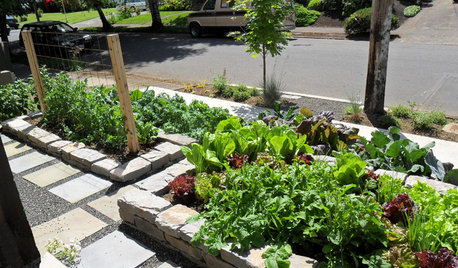Anyone try growing chyote or 'Budha's palm' squash?
macaronicat
19 years ago
Related Stories

FARM YOUR YARD6 Things to Know Before You Start Growing Your Own Food
It takes time and practice, but growing edibles in the suburbs or city is possible with smart prep and patience
Full Story
FRONT YARD IDEASWelcome Edibles Into the Front Yard for Fresh Food and More
Give your front yard design a boost and maybe even make new friends by growing fruits and vegetables
Full Story
FARM YOUR YARDHow to Farm Your Parking Strip
Get an up-close look at a thriving street-side edible garden, one of many sprouting up in Seattle
Full Story
REGIONAL GARDEN GUIDESCalifornia Gardener's March Checklist
Give natives and tropicals a well-deserved spotlight — plus, discover an easy herb that keeps on giving
Full Story
SAVING WATERHouzz Call: Are You Letting Go of Your Lawn?
Many facing a drought are swapping turf for less thirsty plantings. If you’re one of them, we’d like to hear about it
Full Story
GARDENING GUIDESWhat Are Your Spring Gardening Plans?
Tearing out the lawn? Planting edibles? Starting from scratch? Tell us what you plan to change in your garden this year
Full Story
ARCHITECTUREHow to Design a Storybook Cottage
A client’s request: “Build me a house where Disney meets Tudor.” The architect explores the details that make the style
Full Story
SUMMER GARDENINGHouzz Call: Please Show Us Your Summer Garden!
Share pictures of your home and yard this summer — we’d love to feature them in an upcoming story
Full Story
FALL GARDENING11 Trees for Brilliant Fall Color
Give your landscape the quintessential look of autumn with the red, orange and yellow leaves of these standouts
Full Story
LIFEIs Cabin Fever Real? Share Your Story
Are snow piles across the U.S. leading to masses of irritability and boredom? We want to hear your experience
Full Story





barbara_in_la
macaronicatOriginal Author
Related Professionals
Holly Springs Landscape Architects & Landscape Designers · Clemson Landscape Architects & Landscape Designers · Cottonwood Landscape Architects & Landscape Designers · Elwood Landscape Architects & Landscape Designers · Folsom Landscape Architects & Landscape Designers · Seabrook Landscape Architects & Landscape Designers · Williamsburg Landscape Contractors · Barrington Landscape Contractors · Brookfield Landscape Contractors · Del Aire Landscape Contractors · Farmington Landscape Contractors · Huntley Landscape Contractors · Salem Landscape Contractors · Southbury Landscape Contractors · Dallas Roofing & Guttersbellie
TonyfromOz
KarenTX8b
macaronicatOriginal Author
baci
Dino_Tsapatsaris
suzie975
negi
macaronicatOriginal Author
zeedman Zone 5 Wisconsin
macaronicatOriginal Author
kayan
Violet_Z6
zeedman Zone 5 Wisconsin
kayan
cyumickey
Violet_Z6
cyumickey